What began as a "living laboratory" for the scientific study of plants has become one of the most beautiful and popular attractions in the country in the form of Kirstenbosch National Botanical Garden, or Kirstenbosch for short. It's a property of staggering size and beauty, with an interesting history that dates back to the 19th century. Today, Kirstenbosch is one of the many wondrous properties that falls under the jurisdiction of the South African National Biodiversity Institute (SANBI).
In 1811, a botanical collector named William Burchell visited Cape Town. Inspired by the natural beauty of the area, he commented that the establishment of a botanical garden would be greatly beneficial for both scientific enquiry and the public. Of the east-facing slopes of Table Mountain, he wrote: "The beauty here displayed to the eye could scarcely be represented by the most skilful pencil."
A century later, in 1911, a professor of botany, Henry Harold Welch Pearson, along with botanist Neville Pillans and the curator of the Cape Town Municipal Gardens, George Herbert Ridley, set out to look for a site where a new botanical garden could be established. "Pearson was inspired by the country's living assets – its abundant and beautiful flora," and he campaigned for the establishment of a national botanical garden where plants could be studied in their natural habitat. They considered several sites for this ambitious project, finally settling on Kirstenbosch thanks to Burchell's initial effusive comments on the area's beauty.
"The most cherished features of Kirstenbosch are the peace, safety, and unique sense of place that the Garden evokes."
After much deliberation and contestation, Pearson's dream was finally realised in 1913, when Kirstenbosch was opened where what was then called Leendertsbos. It is notable for being the first botanical garden to focus solely on indigenous flora, and since then, it has grown dramatically in size and stature. Given the need for scientific enquiry, Kirstenbosch was developed systematically and deliberately to house its collection of an estimated 7,000 plant species. The result was an assembly of different sections, each a celebration of a different aspect of South African indigenous flora.
Today, Kirstenbosch is home to a vast array of plants, some of them more than 100 years old. However, the garden is not just a collection of plants – it is a curated, carefully designed space that satisfies the need for education, physical activity, entertainment, and the sheer joy of being in nature. "Kirstenbosch is an outdoor classroom of particular splendour" that has inspired, educated, and entertained people for more than a century.
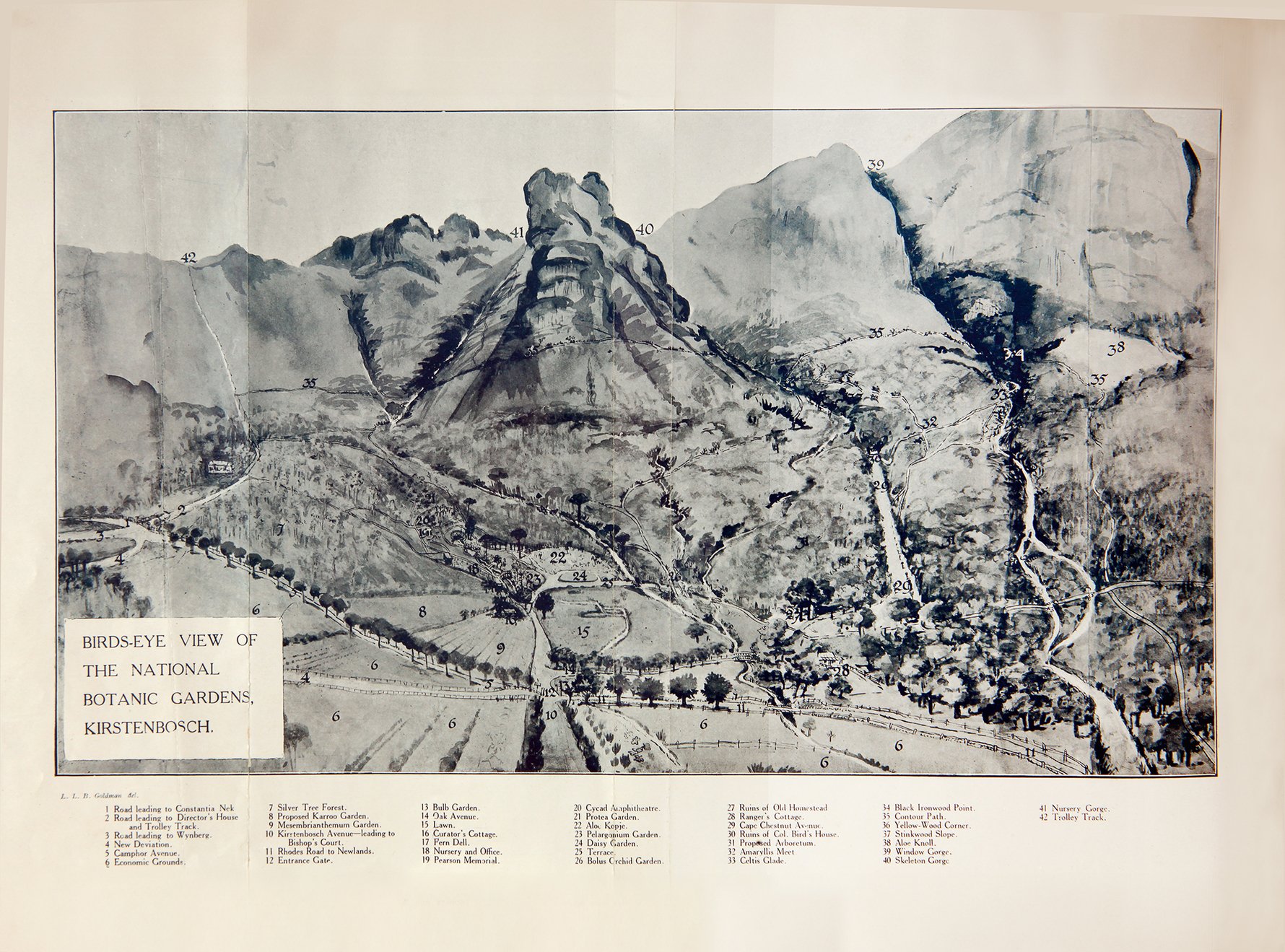
Historical attractions
COLONEL BIRD'S BATHAt the start of the 18th century, financial constraints in South Africa's then British administration resulted in the government selling sections of land, including parts of what is now Kirstenbosch. Some of this land was bought by Colonel Christopher Bird, who, in 1811, built a small pool in the shape of a bird in the heart of Kirstenbosch. Known today as Colonel Bird's Bath, it was originally used to collect spring water. The bath is also part of a myth involving Scottish travel writer, artist and socialite Lady Anne Barnard, who, it is claimed, bathed in the pond. The water in Bird's Bath is clean to drink, making it a delightful attraction with a charming backstory.
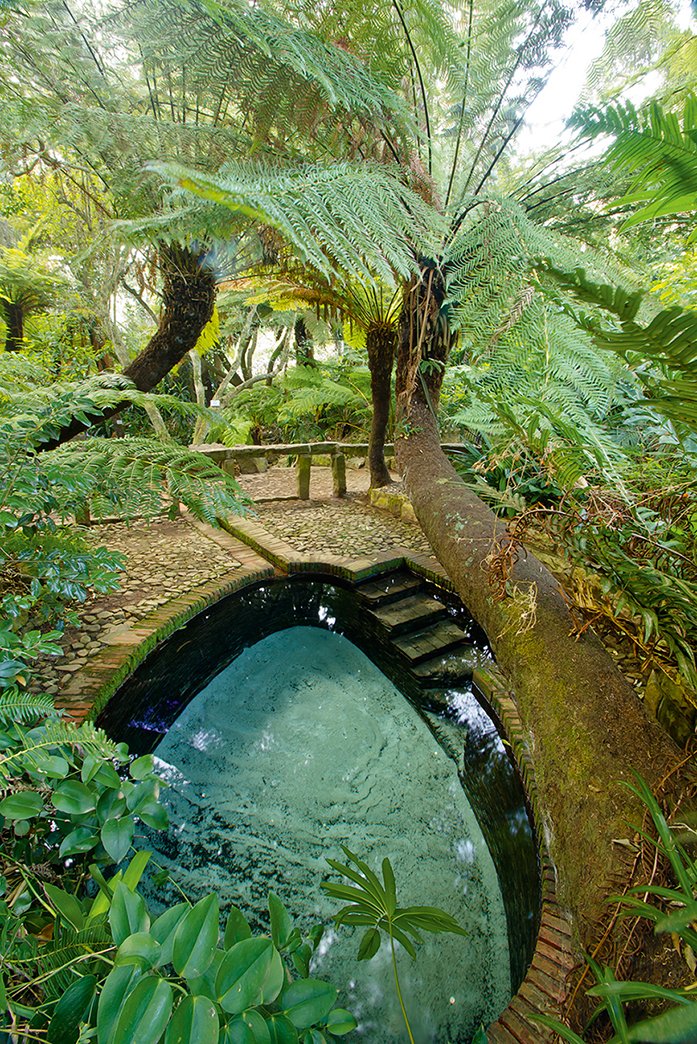
CAMPHOR AVENUE
Throughout his term, then Prime Minister of the Cape Colony Cecil John Rhodes showed concern about the impact of urban development on natural environments. To protect these areas, he bought large tracts of land along the east-facing slopes of Table Mountain. The current site of Kirstenbosch was part of this land, and was left to "the united peoples of South Africa" after his death in 1902. In 1898, Rhodes planted an avenue of camphor trees on a portion of this land to provide him with shade on his rides from Groote Schuur to Constantia. Although these trees are alien species, they weren't removed when the garden was opened in 1913. They have grown into a magnificent, towering canopy that still flanks the path Rhodes travelled, and is now known as Camphor Avenue.
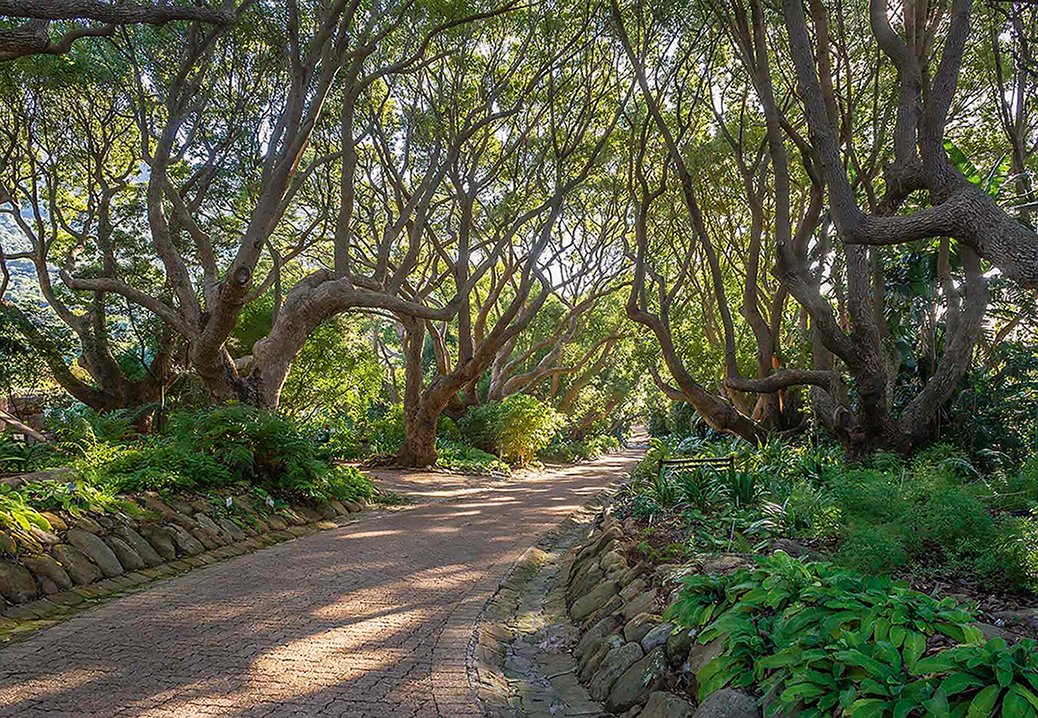
PEARSON'S GRAVE
Pearson's passion for botany gave South Africa, and specifically Cape Town, an exceptional legacy. Thanks to his dedication to the scientific study of indigenous flora, the country has a rich network of institutions and gardens that attract visitors from all over the world. "What made his vision of a new botanic garden so different from others around the globe was his emphasis on the study and preservation of the country's indigenous flora," and this vision won him several awards during his career. When Pearson died in 1916, he was buried on a knoll overlooking his beloved collection of cycads. The site, now backed by an enormous Atlas cedar, is known as Pearson's Grave, and has fittingly been inscribed with the words, "If ye seek his monument, look around you."
Trails and tracks
SILVERTREE TRAIL
Whether you're an avid hiker or someone who enjoys a casual stroll, Kirstenbosch has trails to satisfy all needs. A favourite among these is Silvertree Trail, a 7,75km circular walk that crosses the entire length of Kirstenbosch. The trail borders the Afrotemperate forest of Table Mountain, which used to be home to entire forests of shimmering silver trees, a species that can only be found in a small area of the Cape Peninsula.
Sadly, the mid-1600s saw an increased demand for timber, leading to vast tracts of forest being cut down. In 1657, carpenter and sawyer Leendert Cornelissen was charged with protecting these forests. This part of the forest became known as Leendertsbos, and Cornelissen became the first curator of what became Kirstenbosch. Thanks to his "debauched" behaviour (which included "drinking, celebrating, fighting, brawling, [and] swearing"), Cornelissen's career as curator didn't last very long. Nevertheless, his efforts established the practice of formal conservation efforts in South Africa.
Today, Kirstenbosch, in collaboration with the Botanical Society of South Africa, Table Mountain National Park (TMNP), the Forestry and Agricultural Biotechnology Institute (FABI), and SANBI has launched a project to help save the silver tree.
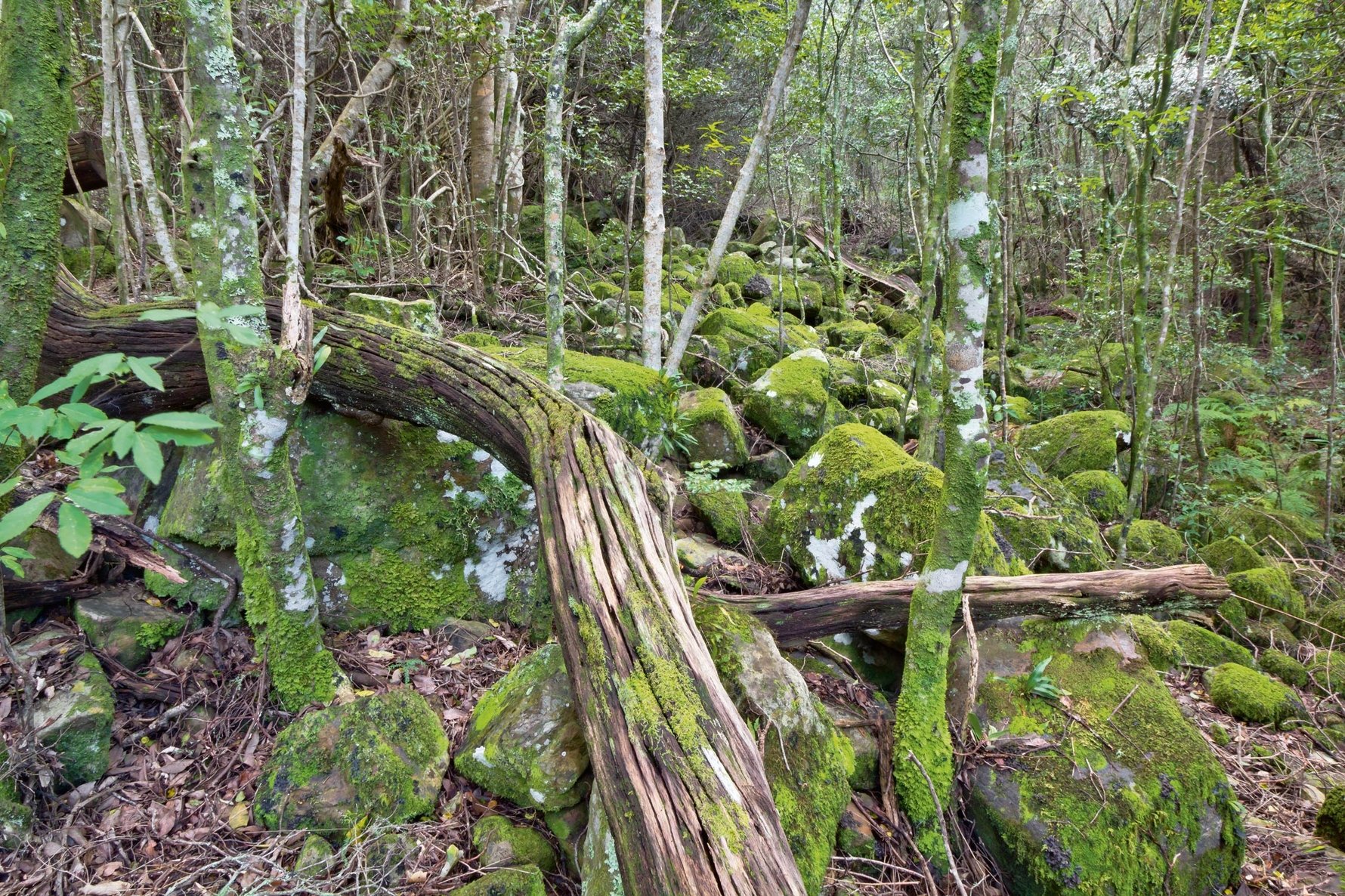
YELLOWWOOD, STINKWOOD, AND BOEKENHOUT TRAILS
The conservation efforts initiated by Cornelissen were further solidified in 1658, when Jan van Riebeeck proclaimed that yellowwood trees were not to be cut down, "no matter under what pretext". Yellowwood trees grow slowly and a popular timber tree, the combination of which drastically reduced the country's tree population. They are also the national tree of South Africa, and the forests of Kirstenbosch are known for their large yellowwoods. Whether you're a flora enthusiast or simply enjoy being in the forest, the 3km-long Yellowwood Trail is a beautiful showcase of these magnificent trees.
Another popular (and therefore scarce) timber tree is stinkwood, which can be found on the 1,5km-long Stinkwood Trail that traverses the oldest part of the forest. If you are pressed for time, the 650m Boekenhout Trail is ideal for a quick view of the mountain. This trail includes alien plants such as stone pines, which were planted in the 19th century, and is an example of the "tolerant approach" taken by botanists when the garden was first designed in 1913.
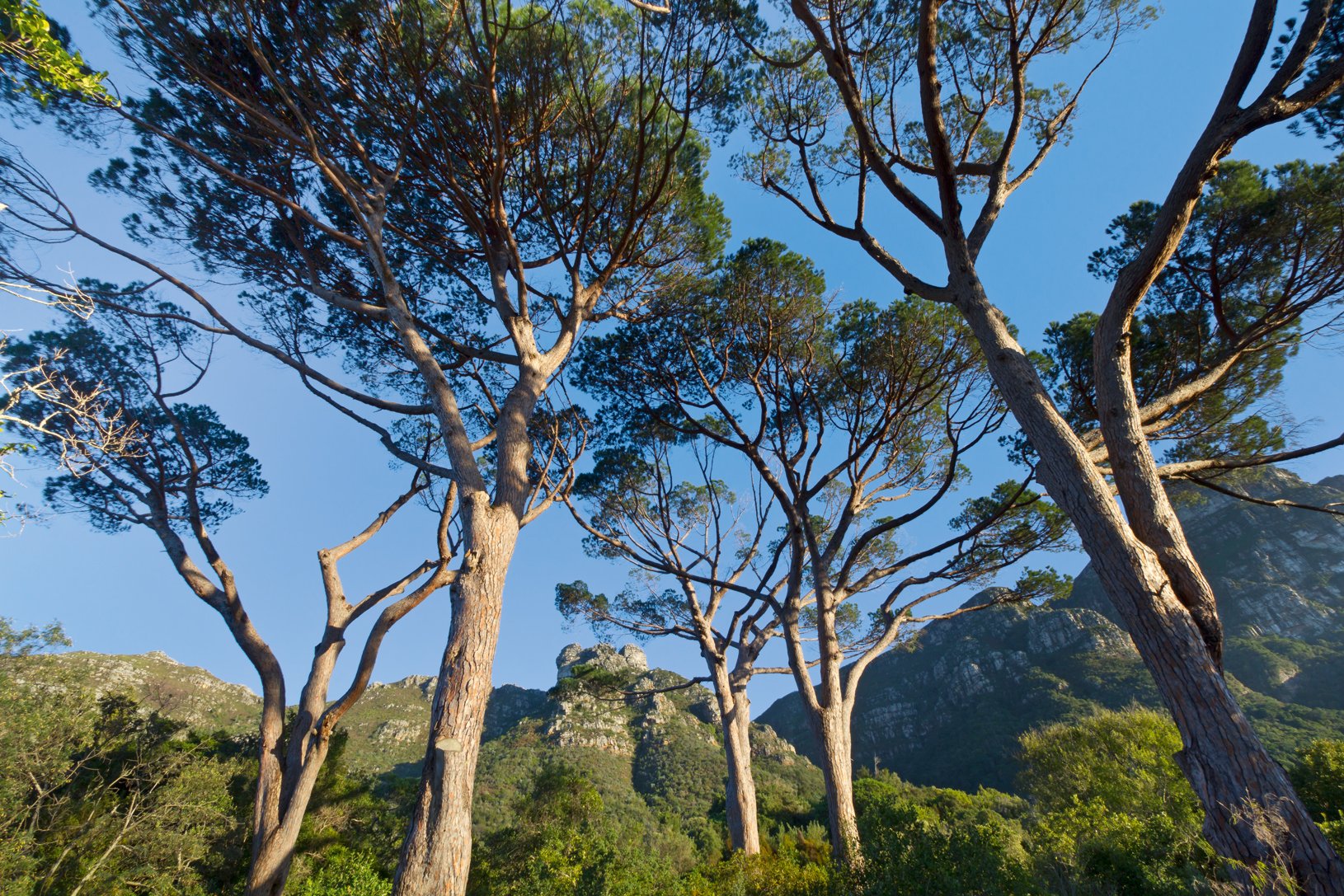
BRAILLE TRAIL
Another interesting feature of Kirstenbosch is the Braille Trail, which is a short 450m-long trail designed to give people who cannot see the opportunity to explore the forest without assistance. With its mulched pathway, braille signposts, plentiful birds and frogs, and fragrant plants, it is a feast for the senses.
SKELETON GORGE AND NURSERY RAVINE
For the more ambitious hiker, there are several longer trail options on Table Mountain. The mountain can be accessed through Kirstenbosch along Skeleton Gorge or Nursery Ravine. Fine examples of Afrotemperate forests, great efforts have been made to conserve these areas. Sadly, despite these efforts, the dense canopy of trees was greatly diminished by the end of the 18th century. Although it will take many years to replace the mighty trees that once stood here, restoration efforts are ongoing and have been relatively successful. Keep in mind that both these trails are incredibly steep, and Skeleton Gorge includes a short scramble to get to the top.
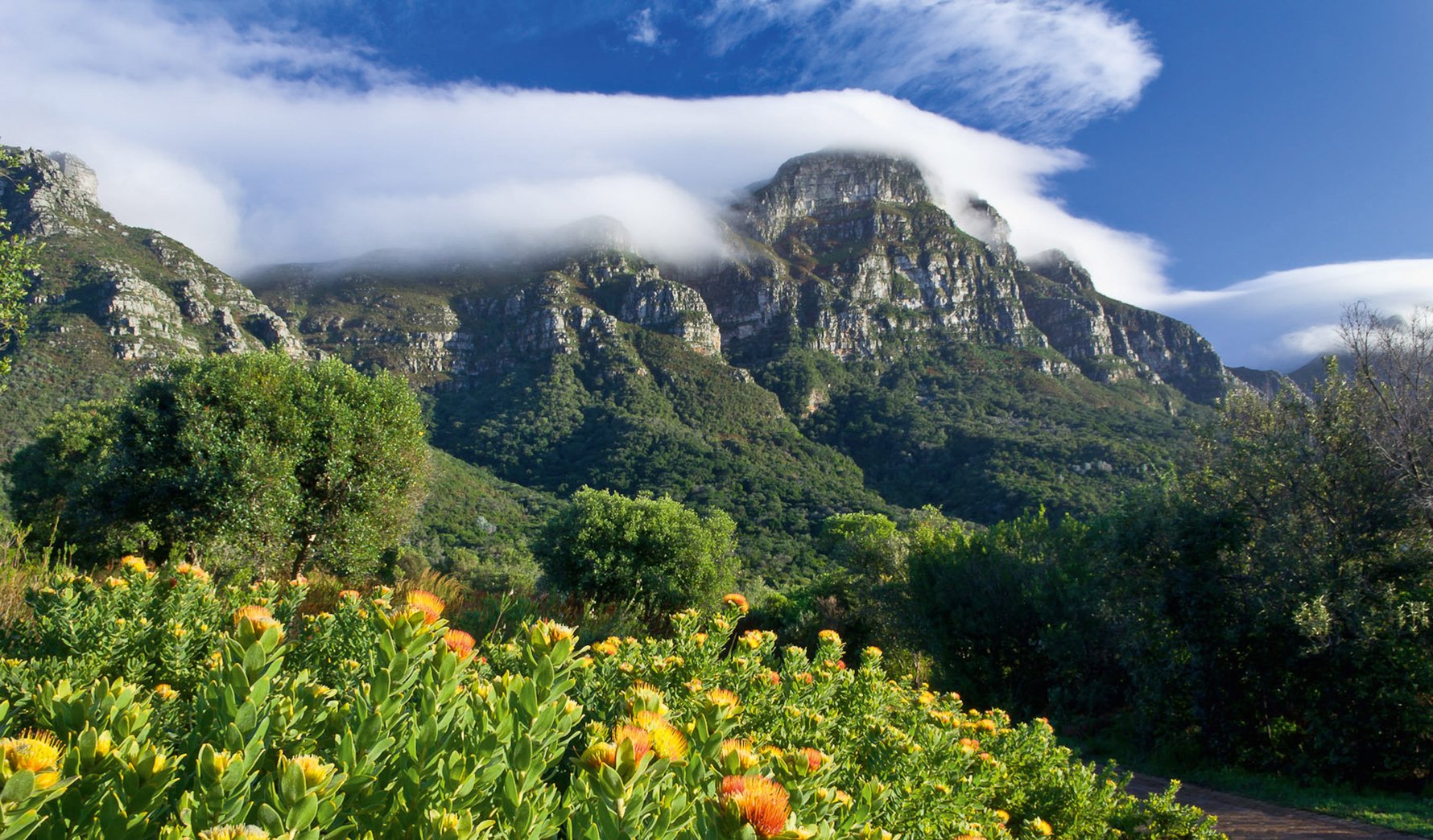
FYNBOS WALK
Fynbos is a uniquely South African biome found only in the Western and Eastern Cape. With its focus on indigenous flora, it is no surprise that this vegetation has a special place in Kirstenbosch. It is estimated that there are more than 8,500 species of fynbos, many of which can be found in Kirstenbosch. The Fynbos Walk meanders through the several gardens dedicated to different fynbos species (see more below), and also crosses the highest points of the garden from where you can see Table Mountain, some of the suburbs of Cape Town, and the Hottentots Holland Mountains.
MARY MULLINS WALKWAY
In the 1990s, the establishment of the National Botanical Institute (NBI) indicated that a new era had arrived in South African plant history. The NBI had ambitious goals, one of them being "to become a world leader in the development of botanical gardens, in plant conservation and education, and in botanical research".
These goals led to the establishment of the Kirstenbosch Development Campaign, the aim of which was to raise money for infrastructure development in the garden. Crucial to this campaign was Mary Mullins, an old benefactor of Kirstenbosch. Among other things, Mullins donated R120,000 to the Kirstenbosch Development Campaign, which was used to build a 1,2km walkway – known as the Mary Mullins Walkway – to give visitors access to the previously inaccessible Protea Garden.
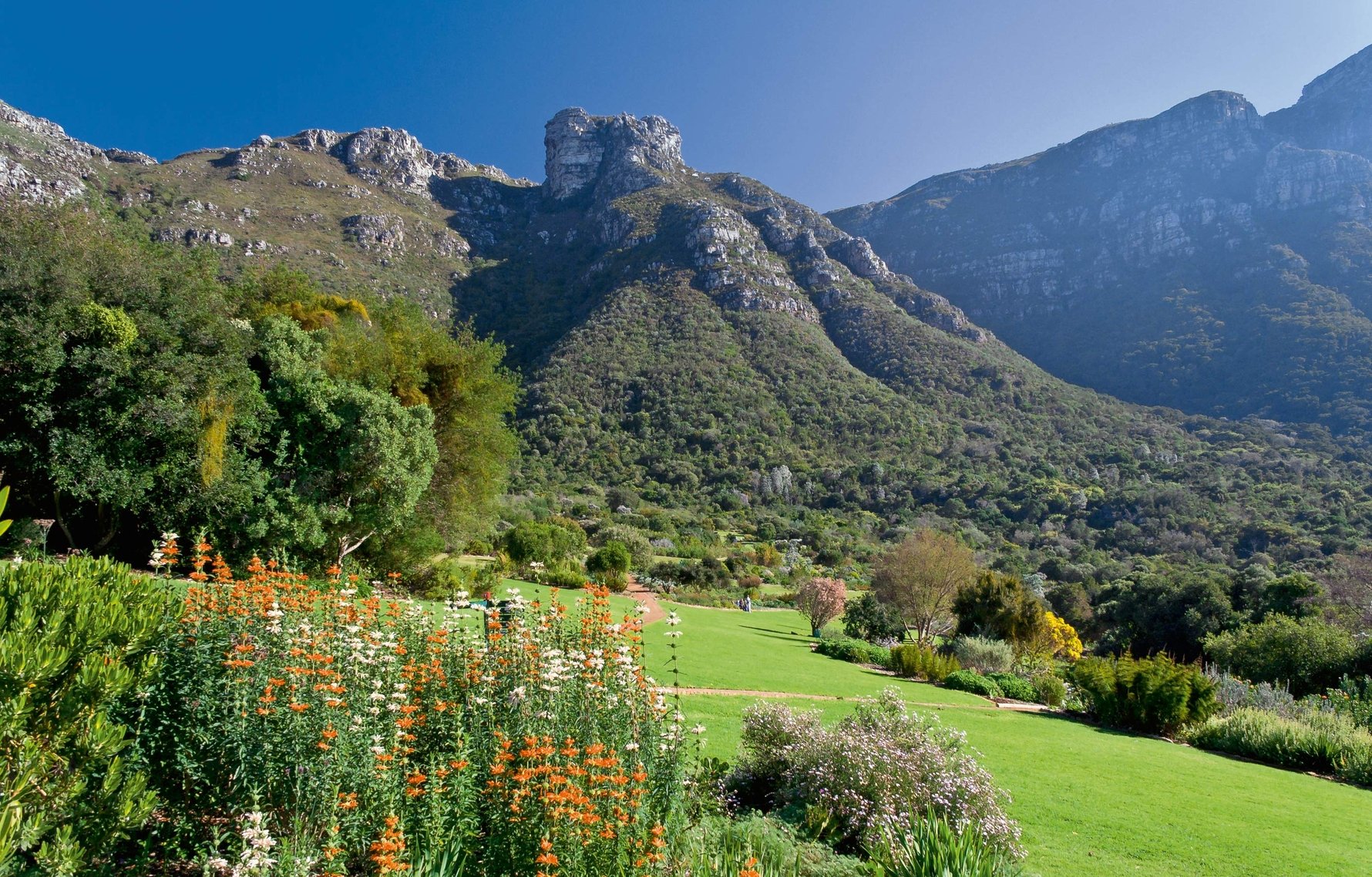
TREE CANOPY WALKWAY
Although the Kirstenbosch Development Campaign concluded in 2015, several new infrastructure projects have been undertaken since then. One of the most popular of these is the Tree Canopy Walkway – or the Boomslang, as it's known locally – which was completed in 2014 in celebration of Kirstenbosch's centenary. The walkway was inspired by the skeleton of a snake, and winds its way from the forest floor through the trees, and out over the canopy. Views from this 130m-long walkway are absolutely spectacular, and definitely not to be missed.

Themed gardens
CYCAD AMPHITHEATREKirstenbosch has been divided into various sections, each with a different focus. The first to be designed was the Cycad Amphitheatre, located in the heart of Kirstenbosch. Having changed very little in the past 200 million years, cycads are often described as "living fossils". Kirstenbosch is currently home to 37 cycad species, including Encephalartos woodii, which is extinct in the wild. Cycads can also be bought at the garden's annual Garden Fair and Plant Sale and at the Garden Centre, although a permit is necessary to own a cycad.
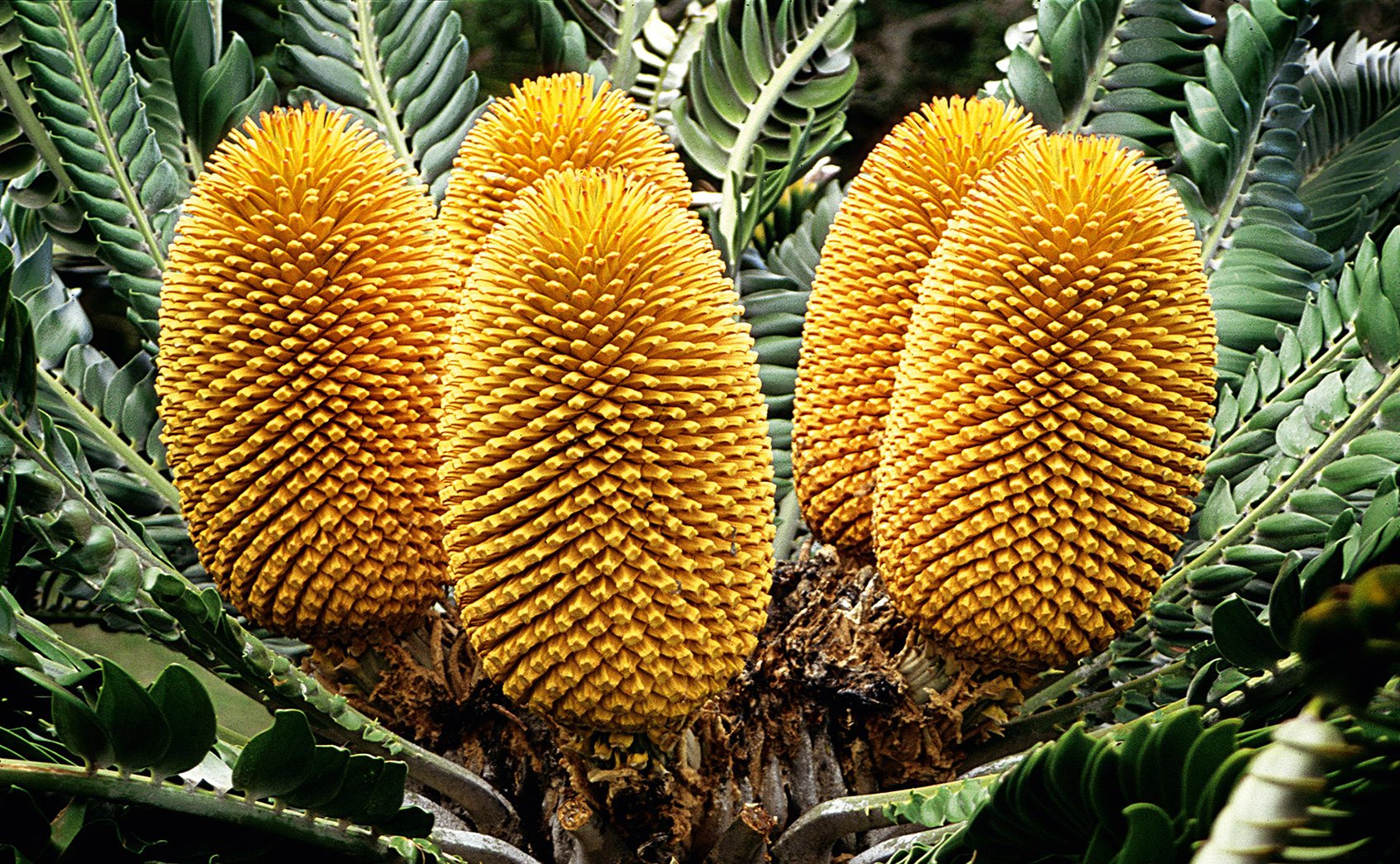
USEFUL PLANTS GARDEN
Also popular is the Useful Plants Garden, which is dedicated to displaying the rich heritage of traditional plant use. Visitors often marvel at the variety of plants in the garden, as well as the medicinal, sustenance, and even magical ends to which they have been applied. This garden is central to Kirstenbosch's efforts to educate: "As younger generations become increasingly isolated from their cultural roots, the garden serves as a unique link to a rich but disappearing heritage." It is also part of the Useful Plants Project, which aims to promote the conservation and sustainable use of useful plants in local communities.
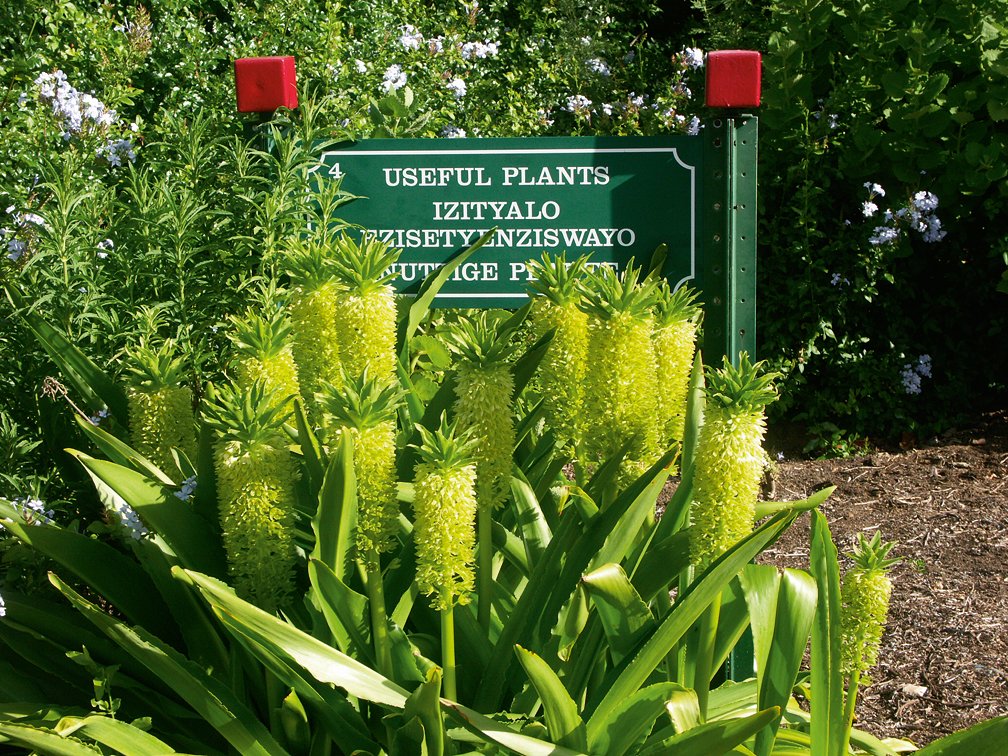
ERICA, PROTEA, AND RESTIO GARDENS
One of Kirstenbosch's biggest attractions is its collection of fynbos species. To this end, several sections dedicated to the various families found in the Cape Floral Kingdom were constructed in the 1960s and 1970s. One of these is the Erica Garden, which dates back to 1972 and is home to an estimated 770 species of Erica, many of which bloom throughout the year. In the Protea Garden, visitors can enjoy a wide array of protea species, including the ever-popular pincushion proteas and South Africa's national flower, the king protea. Kirstenbosch is also home to the Restio Garden, where visitors can view 55 species of Cape reeds.
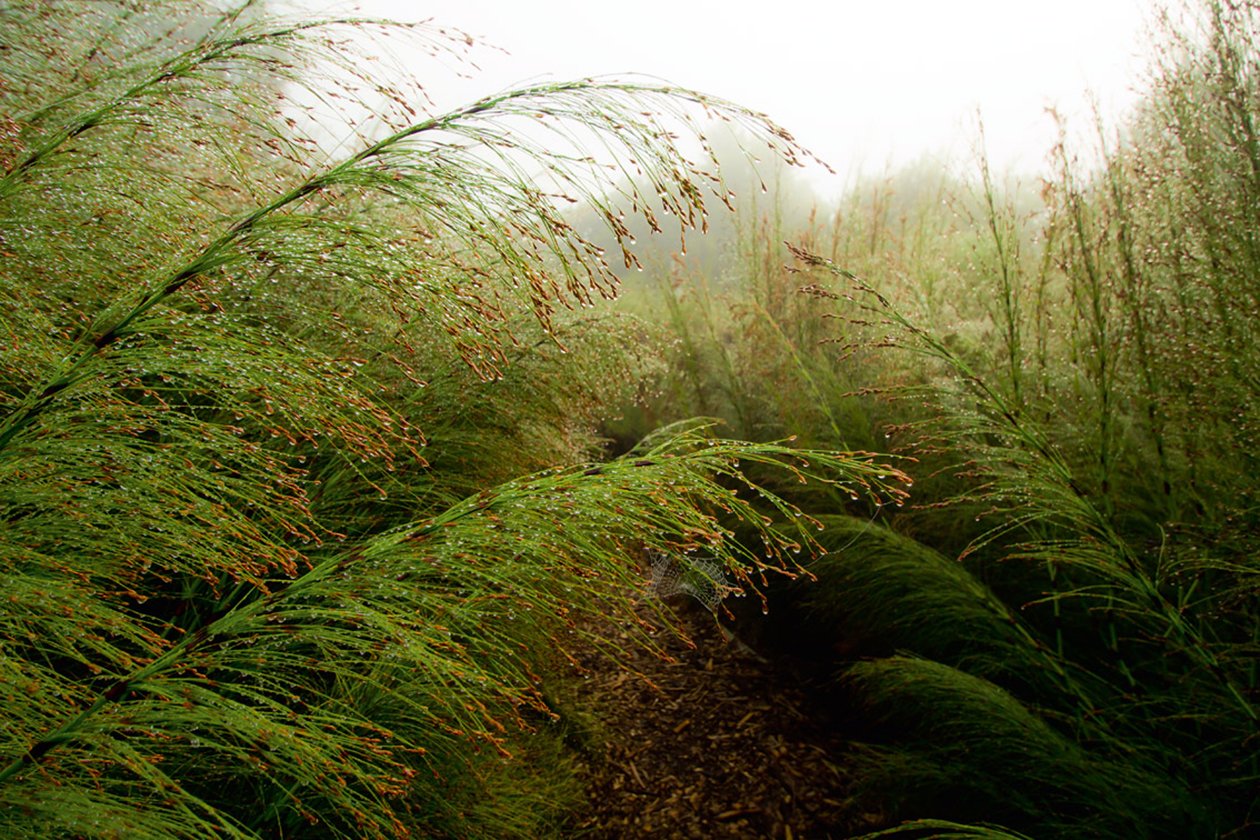
BUCHU AND FRAGRANCE GARDENS
Also central to South Africa's flora heritage is buchu, which is a fynbos herb with medicinal properties that tastes and smells vaguely like blackcurrant. There are 314 species of buchu in the country, and Kirstenbosch's Buchu Garden is home to 55 of these. If the smell of buchu is not for you, the Fragrance Garden houses a variety of aromatic plants, including honeysuckle, mint, and wild garlic. A celebration for your nose, the Fragrance Garden also forms part of the Braille Trail.
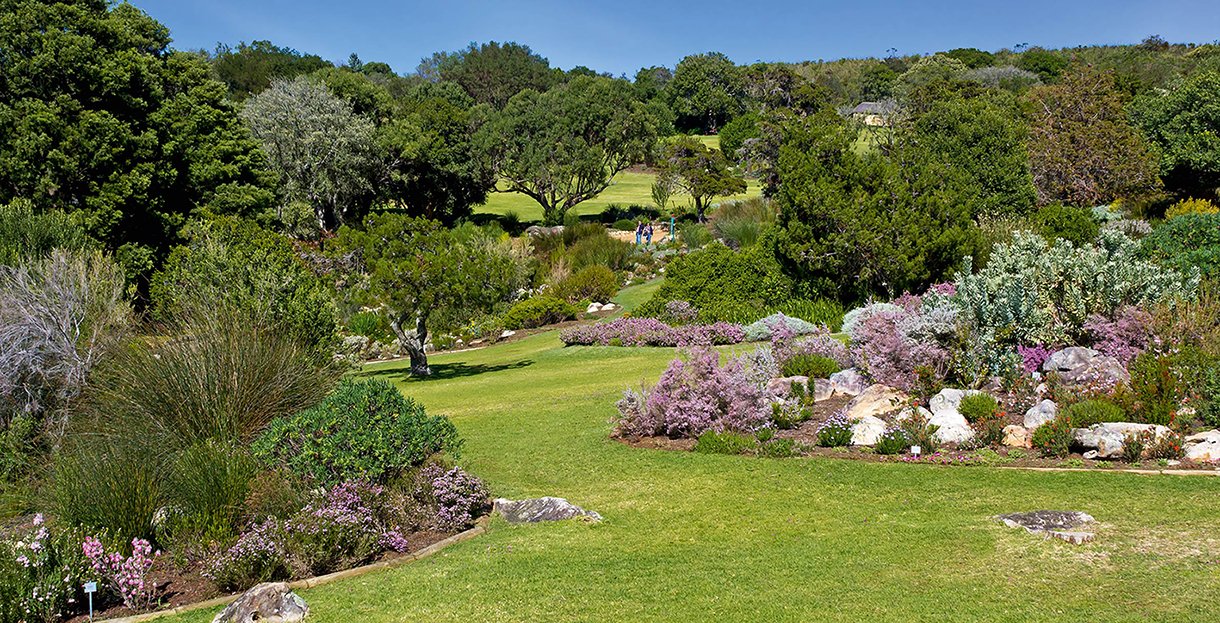
GARDEN OF EXTINCTION
Far from merely celebrating the useful and the beautiful, Kirstenbosch is also committed to raising awareness about soon-to-be extinct plants. However, the journey to fulfilling this objective has not been an easy one. In 2000, the nursery, living collections and threatened species manager of Kirstenbosch, Anthony Hitchcock, realised that caring for the more than 1,000 species from the Cape Floral Kingdom that was under threat at the time would be a mammoth, and likely impossible, task. Pearson noted in 1911: "Protection, to be effective, must be applied, and strictly applied, to areas, not to selected species." Using this principle, the Threatened Species Programme was developed, which included the creation of the Garden of Extinction. Here, visitors can view threatened plant species, including several that are extinct in the wild.
WATER-WISE AND WEED GARDENS
The world is facing an increasingly urgent water shortage, which is why the choice was made to create a water-wise garden. Here, visitors are educated about the sustainable use of water in landscaping by being introduced to plants according to their resilience, sustainability, and ability to adapt to drought. Another popular themed garden is the Garden of Weeds, which was vegetated using plants that have come to be regarded as weeds in other parts of the world. The aim of this garden is to raise awareness about alien and invasive plant species, and the need to control these to maintain a sustainable natural environment.
"[Kirstenbosch] was inspired by the country's living assets – its abundant and beautiful flora."
An abundance of aloes
In addition to the lovely themed gardens, visitors should also look out for Kirstenbosh's magnificent aloe collection, specifically aloe personii, which was named after Pearson. Also of historical significance is Mandela's Gold – rare and beautiful strelitzia scattered throughout the garden. When former President Nelson Mandela visited the garden in 1996, he noted the following, "I am happiest when I am in the wild because I can always listen... I am very happy that you have done me the honour of being associated with this remarkable place, Kirstenbosch."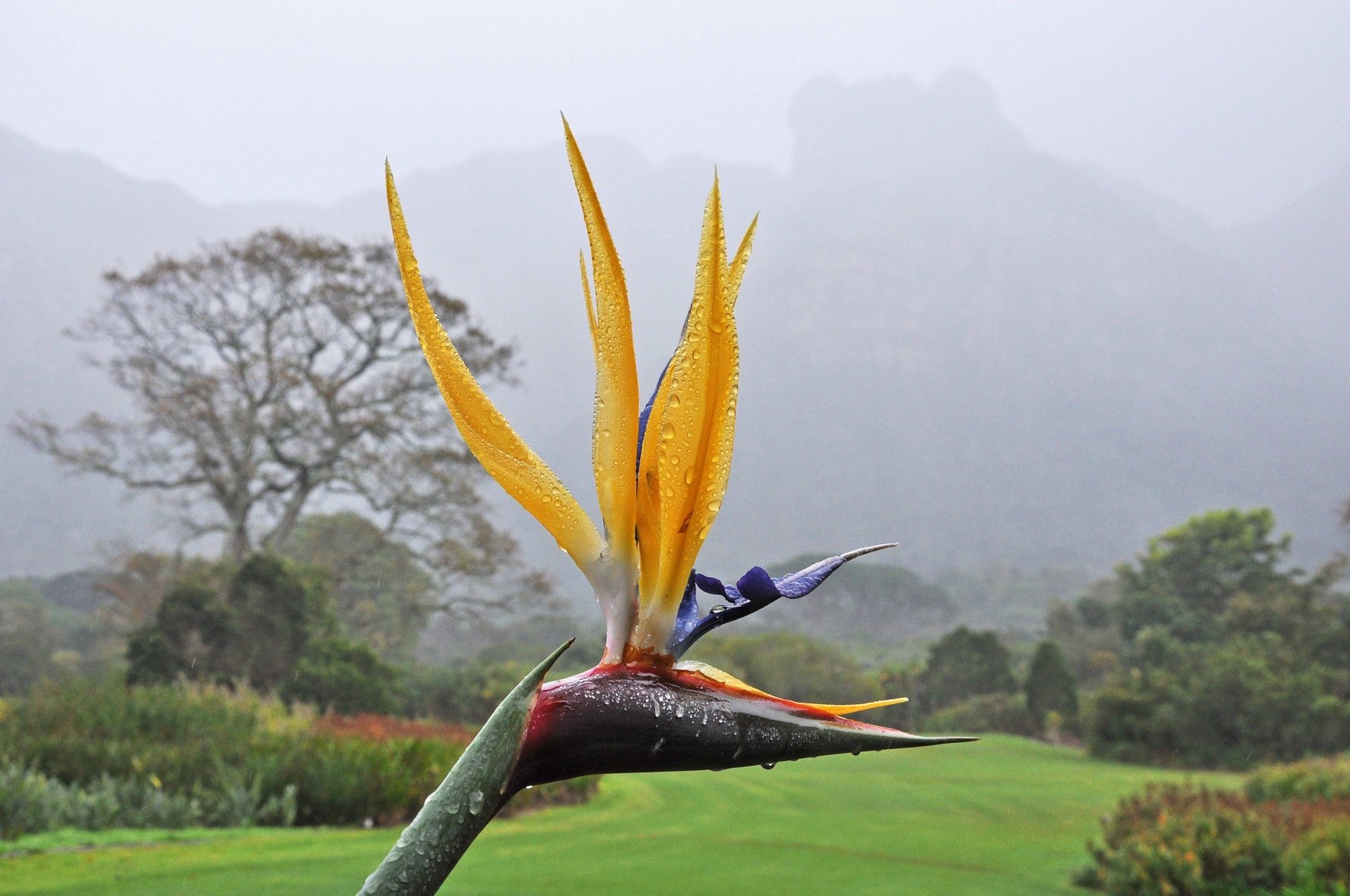
Through the seasons
While the gardens are beautiful year-round, Kirstenbosch is especially spectacular in the springtime. Known for its colourful annuals, hundreds of visitors flock to the garden every year to view this incredible display. Kirstenbosch also has many succulents, and these are the main attraction during the winter. About 4,000 species of succulents are found in South Africa, making up 40% of the world's total, and part of Kirstenbosch's charm is the celebration of this important part of the country's flora.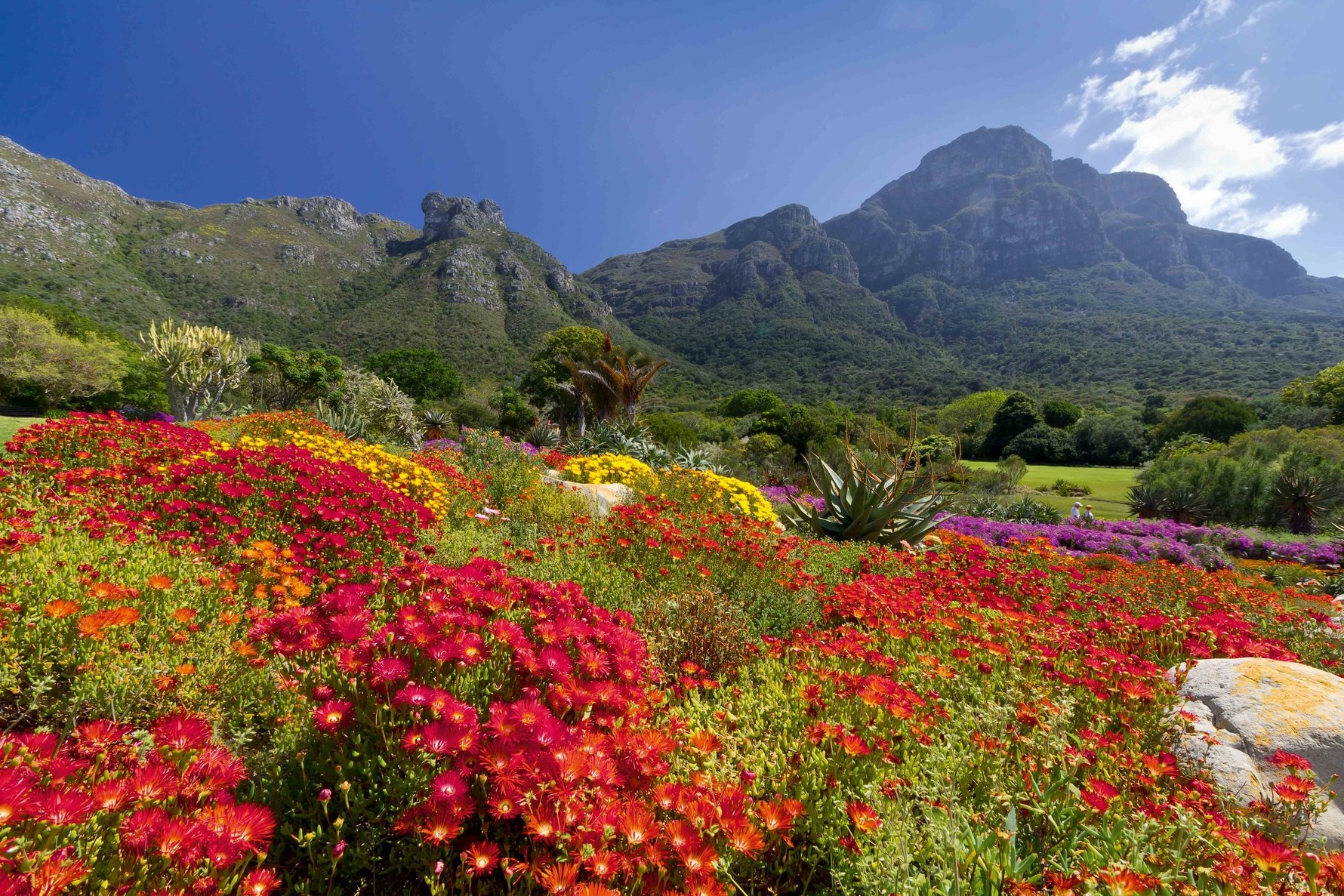
Specialist plant viewing and research
COMPTON HERBARIUMIf outdoor plant viewing is not enough, Kirstenbosch offers several indoor spaces that specialise in the cultivation of specific plants. Of these, the oldest is the Compton Herbarium, currently located in the Kirstenbosch Research Centre. Following a somewhat tumultuous time in the history of scientific enquiry at Kirstenbosch (which included the removal of the current Bolus Herbarium to the University of Cape Town), botanist and longest-serving director of Kirstenbosch, Robert Harold Compton, set out to build a new herbarium at Kirstenbosch. His efforts led to the establishment of the Botanical Assistantship in 1933, the employment of three botanists in 1940, and a collection of 9,908 herbarium specimens in the same year.
Despite the struggle, Compton believed that "this successful beginning of the new herbarium gave great encouragement to the belief that the gardens were after all by nature a definitely botanical centre". When the herbarium was moved to the research centre in 1996, the building was converted into the garden curator's offices. Also included in this complex are the Visitor's Centre and the Botanical Society Conservatory, where the four different biomes from southern Africa can be seen.
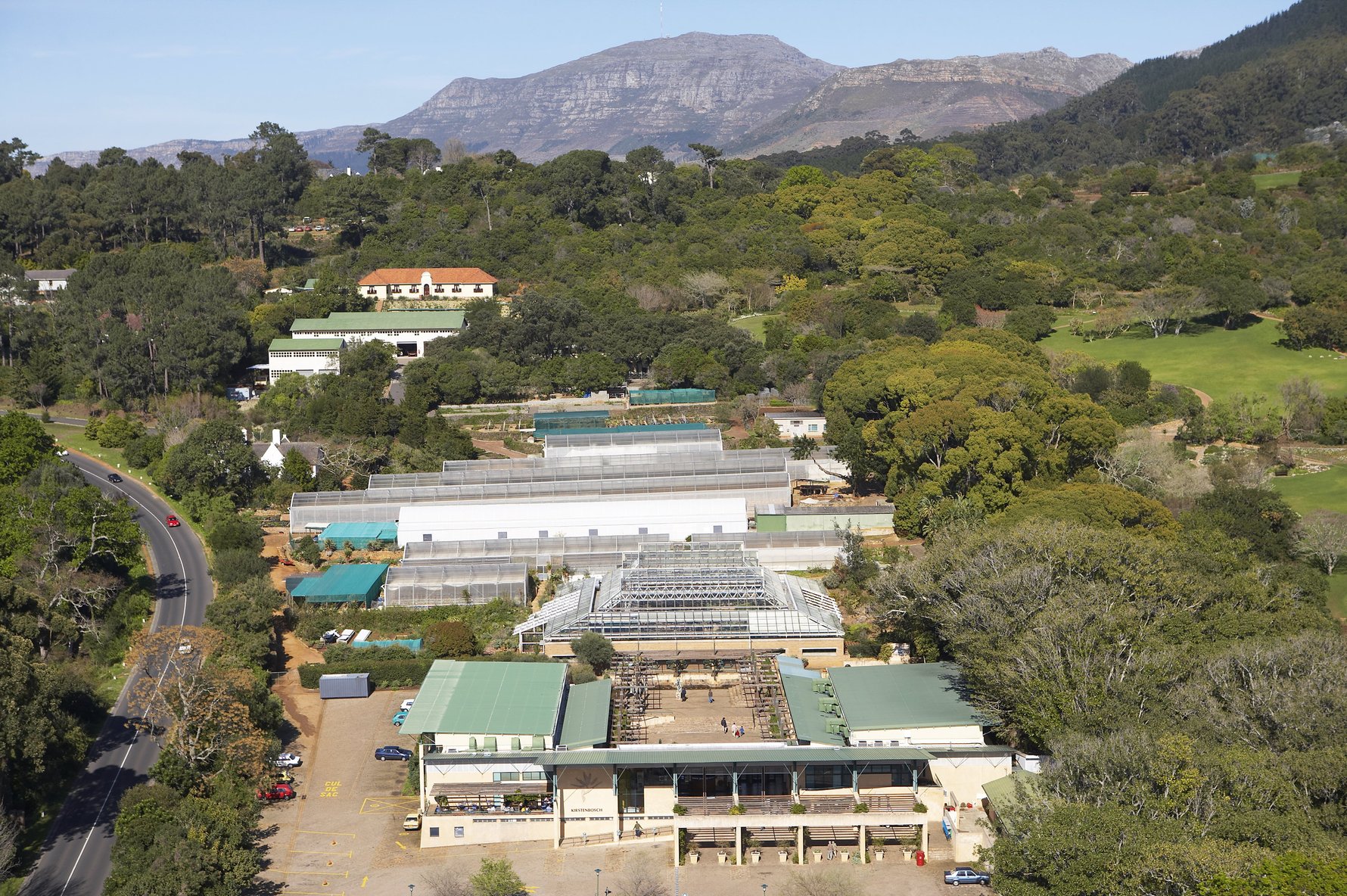
MILLENNIUM GLASSHOUSES
The Millennium Glasshouses of Kirstenbosch are where much of the magic happens: here, the garden's extensive collection of bulbs, succulents, and plants of conservation importance – or threatened species – are housed. "The primary objective of botanical gardens is to establish collections of living plants in accord with aesthetic, scientific, and educational arrangements, presented in displays accessible to the public."
Far from being a mere "stamp-collecting" activity, the glasshouses of Kirstenbosch predominantly centre on conservation efforts. However, collections housed in glasshouses such as these have several limitations when it comes to conservation efforts, which is why the garden also includes a Threatened Species Programme to aid these efforts.
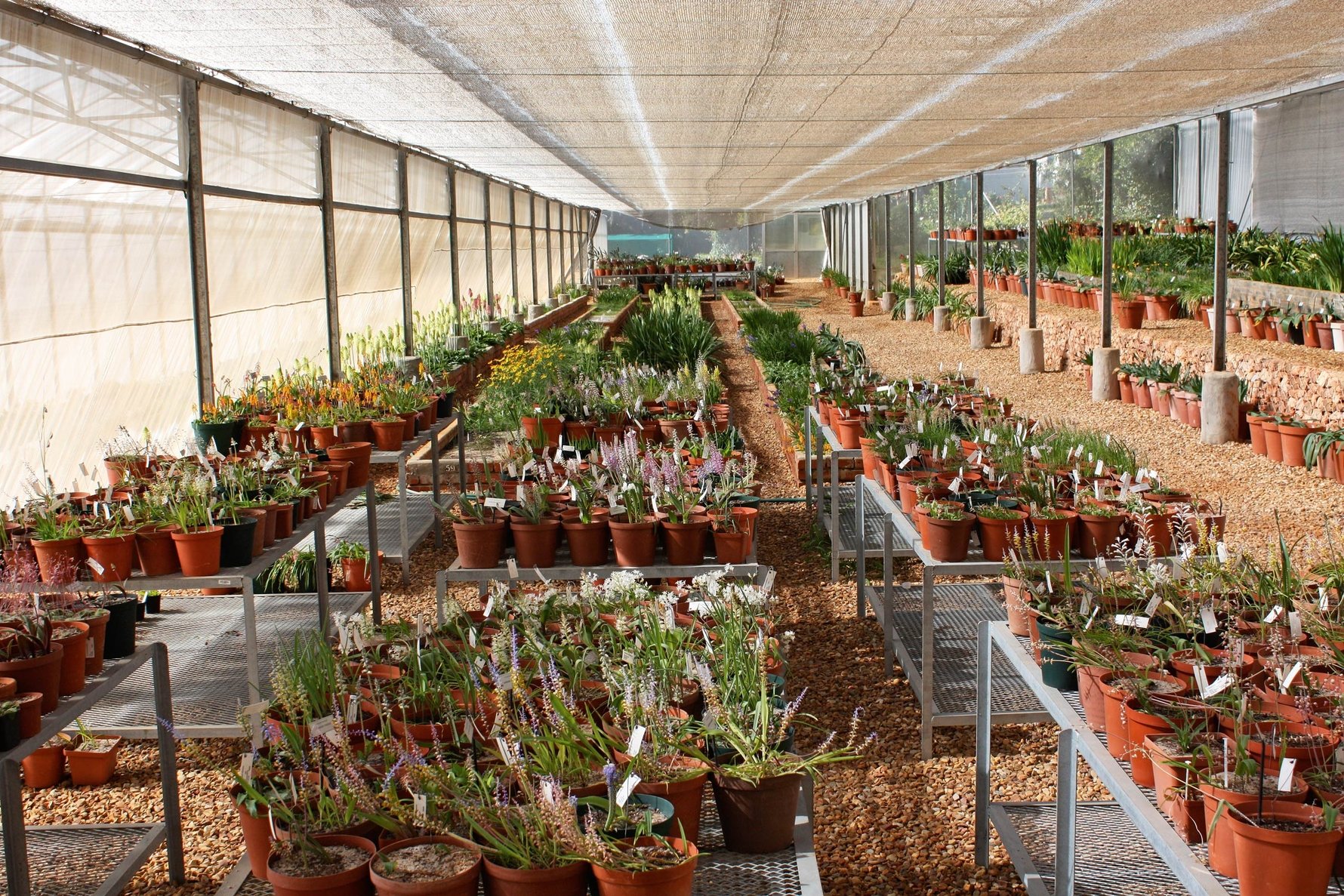
BOTANICAL SOCIETY CONSERVATORY
The Botanical Society Conservatory was designed by Cape Town architect Julian Elliott to house the garden's extensive succulent collection. Its centrepiece is a large baobab tree that was transported an estimated 2,000km from the Limpopo valley to Kirstenbosch. In addition to succulents, the conservatory also houses the rocks and soils that these succulents need to grow and flourish. This makes the conservatory both a "botanical and geological museum" in which mini ecosystems sustain plants from different regions. Interestingly, given these different regions, the displays alternate and are never dormant or in flower at the same time.
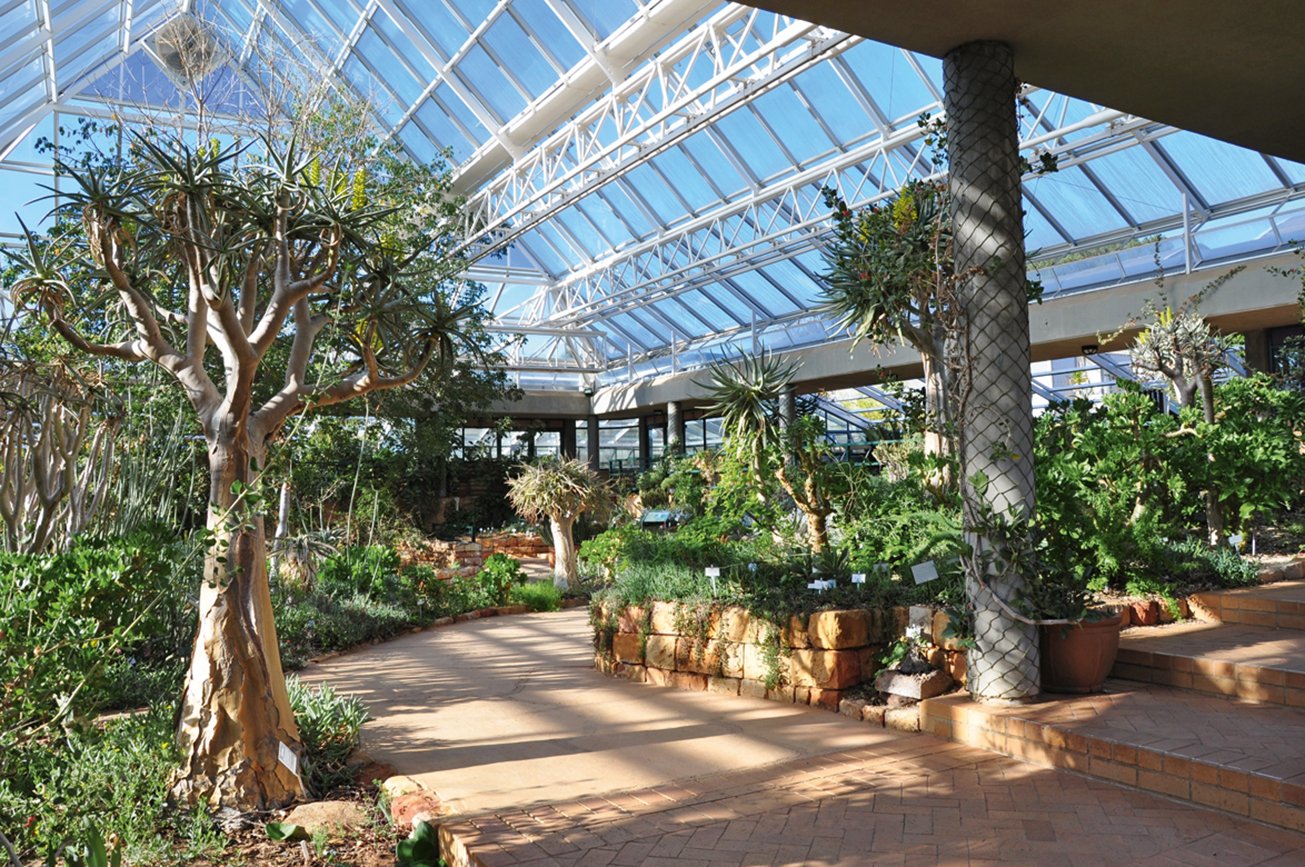
ARBORETUM
An arboretum is a place where trees are studied, and with its collection of 450 tree species, Kirstenbosch's Arboretum is quite spectacular. In addition to trees, this section of the garden also houses bulbs, shade-loving perennials, shrubs, and subtropical ground covers, all accessible along mulch-covered pathways. The biggest attraction in the Arboretum is undoubtedly the 18m-tall tree aloe that flowers in June; however, the shades of purple, blue, and white of flowering spur flowers and the bursts of orange from scattered clivias are not to be sneezed at.
Other attractions
OTTER AND MAIN PONDS
In addition to its rich history, beautiful trails, and unique themed gardens, Kirstenbosch also offers a number of other attractions. Foremost among these is Otter Pond, which is shaded by a large African mahogany tree and enclosed by a stone wall. The pond got its name from a sculpture donated by Llewellyn Davies in 1994 to commemorate the once-abundant otter population around Table Mountain. Inscribed on the sculpture are the words, "Our quality of life will depend on the ability of mankind to live in harmony with nature." Kirstenbosch also houses a much larger pond known as Main Pond, which is situated where visitors can get an incredible view of Table Mountain and the garden's sweeping lawns.

THE DELL AND MATHEWS ROCKERY
Also in Kirstenbosch is The Dell, an oasis in an already lush environment. Characterised by cobbled paths and tall trees, this was one of the first areas in Kirstenbosch to be developed and was once thought of as the centrepiece of the garden. Additionally, the first nursery in Kirstenbosch was built in the lower part of The Dell in 1913, and the path dates back to 1914. This section of the garden is also home to many species of ferns and other shade-loving plants.
Mathews Rockery is equally significant in the historical development of Kirstenbosch: built in the 1930s by Pearson's right-hand man and trained plantsman, Joseph 'Jimmy' William Mathews, the rockery is emblematic of the hard landscaping found in this region. It is also home to many succulents, and was built using locally cut sandstone.
ENCHANTED AND FLEDGING FORESTS
As for forested areas, Kirstenbosch has many. First on the list is the Enchanted Forest, which can be found on the warmer, north-facing slopes of Kirstenbosch. A relatively new development, this section of the garden is home to 450 different trees of the more than 1,000 tree species found in South Africa. Among these are pioneer species such as the keurboom, tree fuschia, turkey berry, wild pear, and Cape myrtle, which, along with scores of clivia, turn the forest into a mass of mauve, blue, and white during autumn. Kirstenbosch is also home to the Fledgling Forest, which is a demonstration of the development of forests.
PELARGONIUM KOPPIE AND SCULPTURE GARDEN
On the rocky outcrop known as Pelargonium Koppie, visitors are treated to the close relatives of geraniums, pelargoniums. Today, the sale of geraniums is a multimillion-dollar industry in Europe, predominantly as a result of the 400 species of geraniums that were collected from the Cape in the late 1700s and introduced into the Royal Botanic Gardens in Kew, England. Aside from a celebration of all things indigenous, Kirstenbosch is also home to a Sculpture Garden, which features a rotating selection of Zimbabwean Mambo stone sculptures. While the main feature of the garden is the flora, the inclusion of these sculptures was important because they "provided a tangible link to traditional cultures and belief systems".
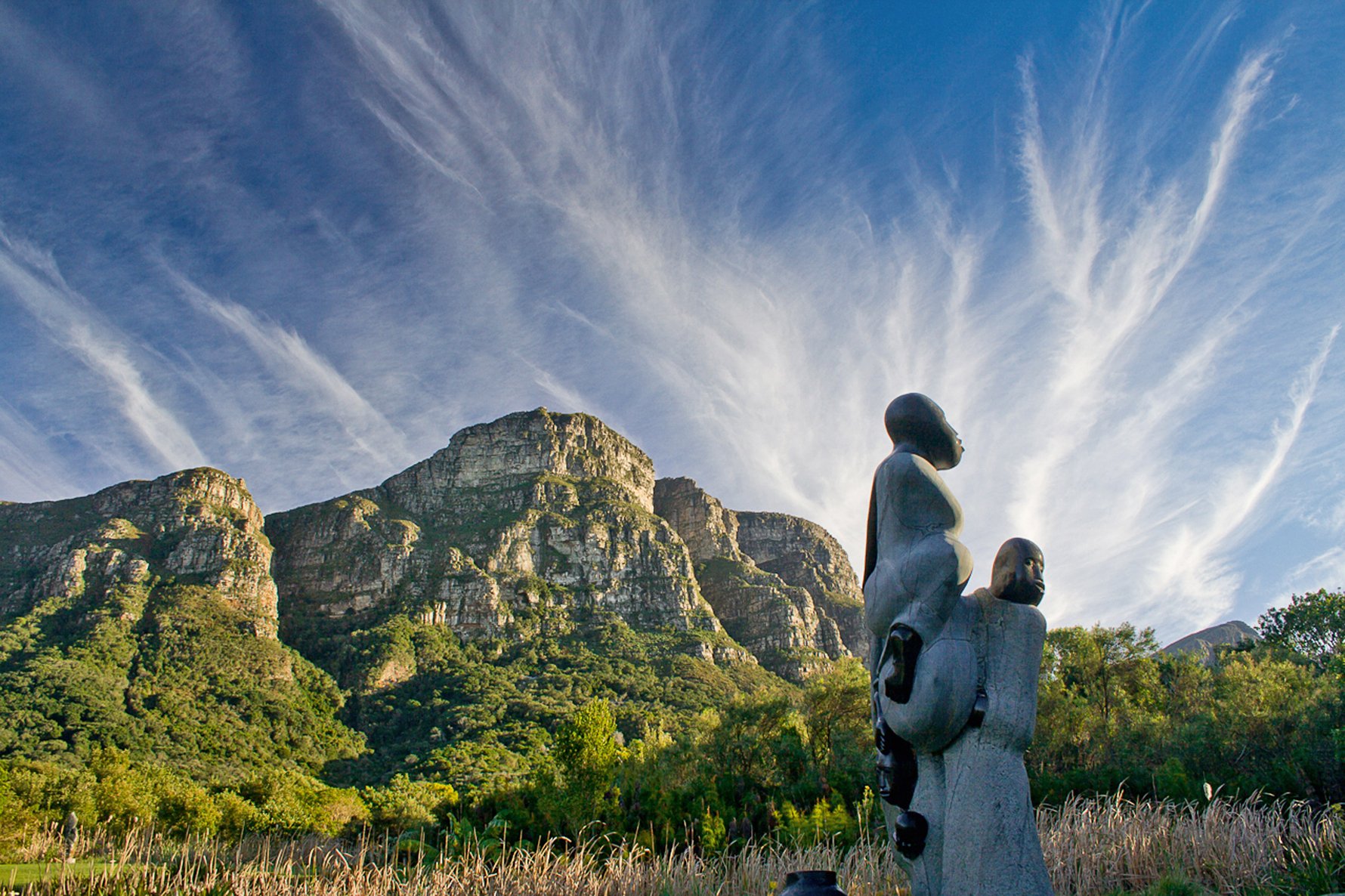
Activities and events
WILDLIFE WATCH
Kirstenbosch is not only about flora. Home to a recorded 139 bird species, it is also a popular destination among bird watchers. Other attractions include critters, amphibia, and wildlife including the marsh terrapin, Cape fox, small grey mongoose, and endangered species such as the Table Mountain ghost frog.
RUNNING AND MOUNTAIN BIKING
Additionally, the many trails in Kirstenbosch make it a popular destination for runners and mountain bikers.
FAIRS AND FESTIVALS
The garden hosts regular events, including an annual Plant Fair, Summer Sunset Concerts, and Carols by Candlelight. No matter the season, Kirstenbosch has got you covered!
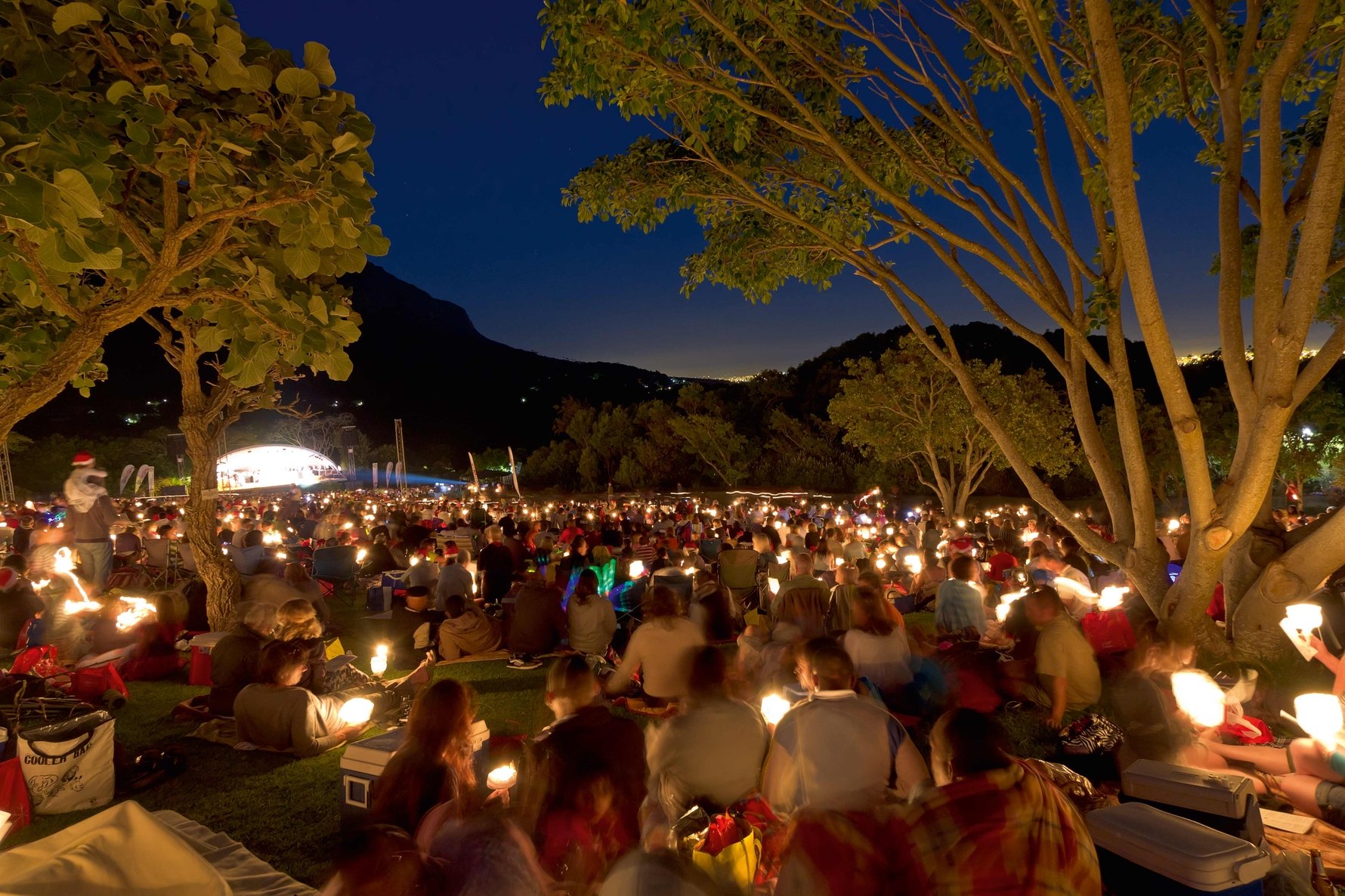
Facilities
RESTAURANTS AND CAFÉS
The garden also houses a number of retail facilities. Foremost among these is the Fynkos tea room, which was built in 1922 and then rebuilt in 1988 after it burned down. Here, visitors can enjoy a glorious choice of salads, sandwiches, soups, cakes, and desserts, as well as, of course, a selection of teas. For coffee lovers, Kirstenbosch is also home to Vida e Caffè, and MOYO restaurant will delight foodies who enjoy African-inspired flavours.
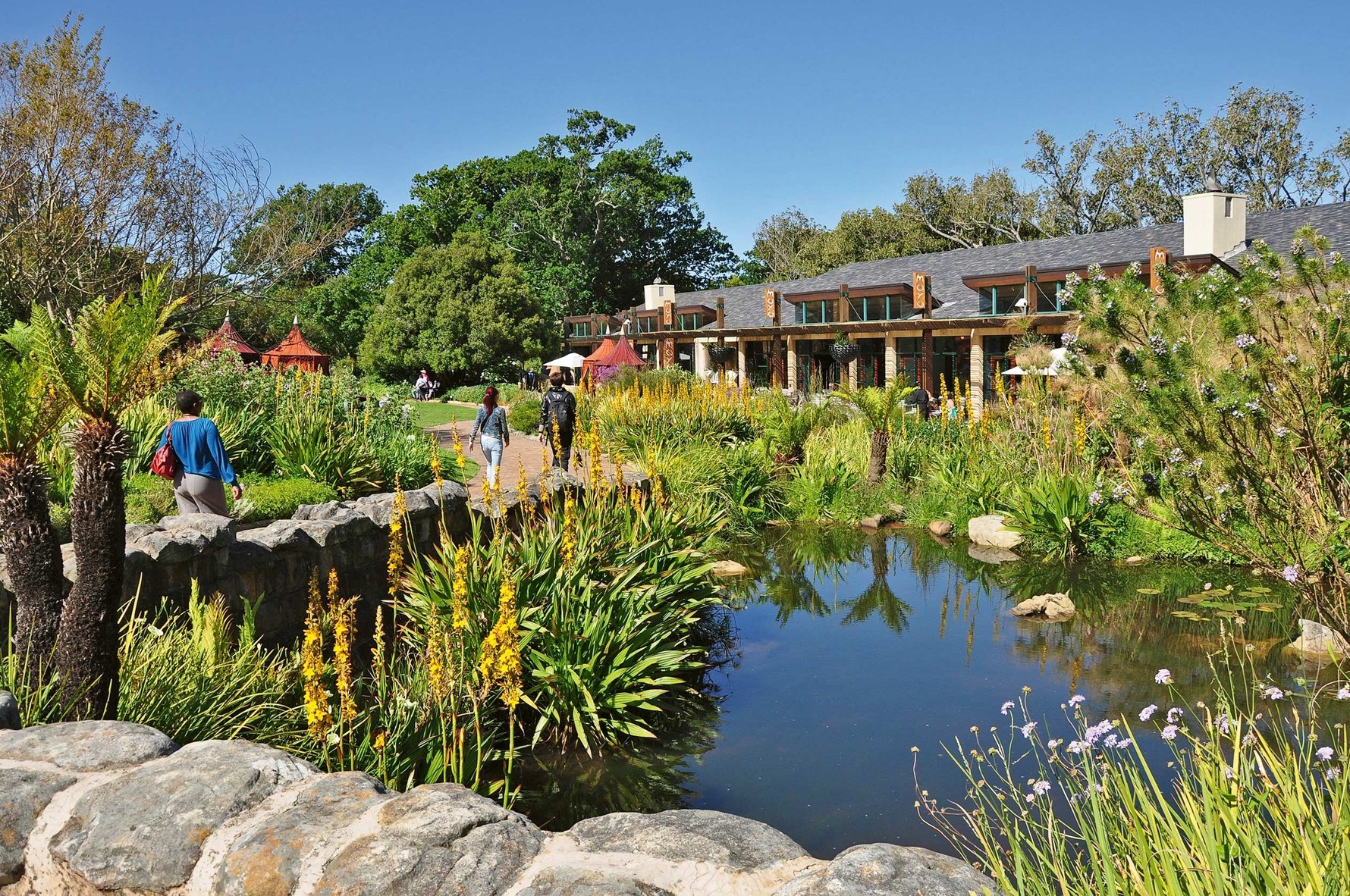
PLANT NURSERY
If a walk through Kirstenbosch has inspired you to up your own gardening game, the Garden Centre sells a large collection of indigenous plants. It can be accessed from the parking lot, so you don't need to pay an entrance fee.
PICNIC SPOTS AND VIEWING DECKS
Kirstenbosch also has a Marquee Lawn where large functions and dinners can be held, as well as a selection of smaller lawns that are ideal for family outings and summer picnics. Last but not least, the Kirstenbosch Viewing Deck offers visitors spectacular views of the garden against the backdrop of the east-facing slopes of Table Mountain.
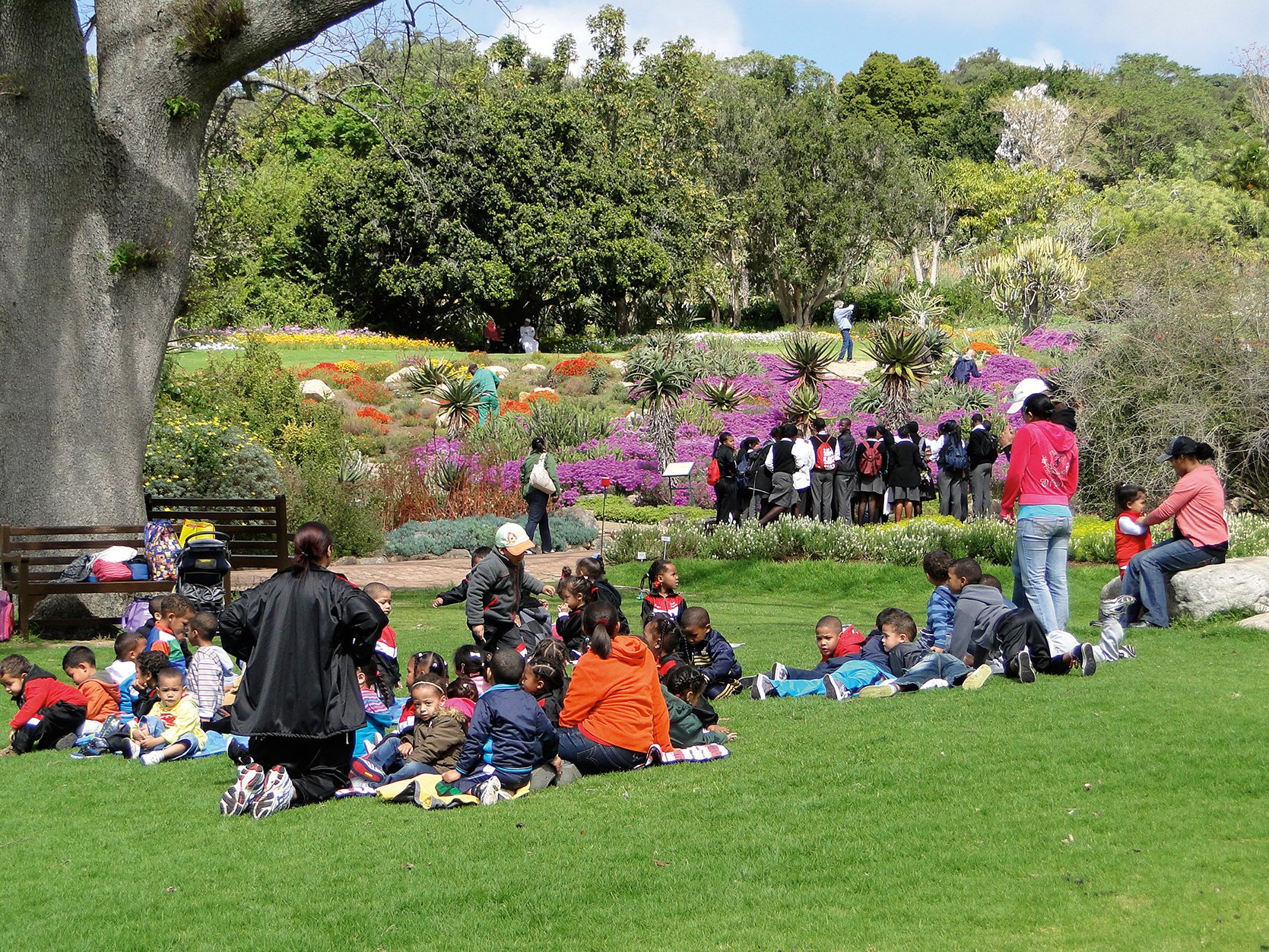
DOG-FRIENDLY SECTIONS
For dog lovers, there are several sections where your furry friend is allowed. For more information, view this helpful map here. Keep in mind that your dog must be on a leash at all times, and dogs are not allowed to disturb, chase, or kill any animals, birds, mountain bikers, runners, garden staff, or visitors. It is also important to clean up after your dog so that everyone can enjoy a clean and pristine garden!
100 years of botanical beauty
Since it opened in 1913, Kirstenbosch has inspired and entertained visitors from all over the world, and has been the site of vital research in the fields of horticulture and botany. It has also been a source of much-needed conservation efforts. That being said, Kirstenbosch is more than the sum of its parts: "The most cherished features of Kirstenbosch are the peace, safety and unique sense of place that the garden evokes."
Further reading
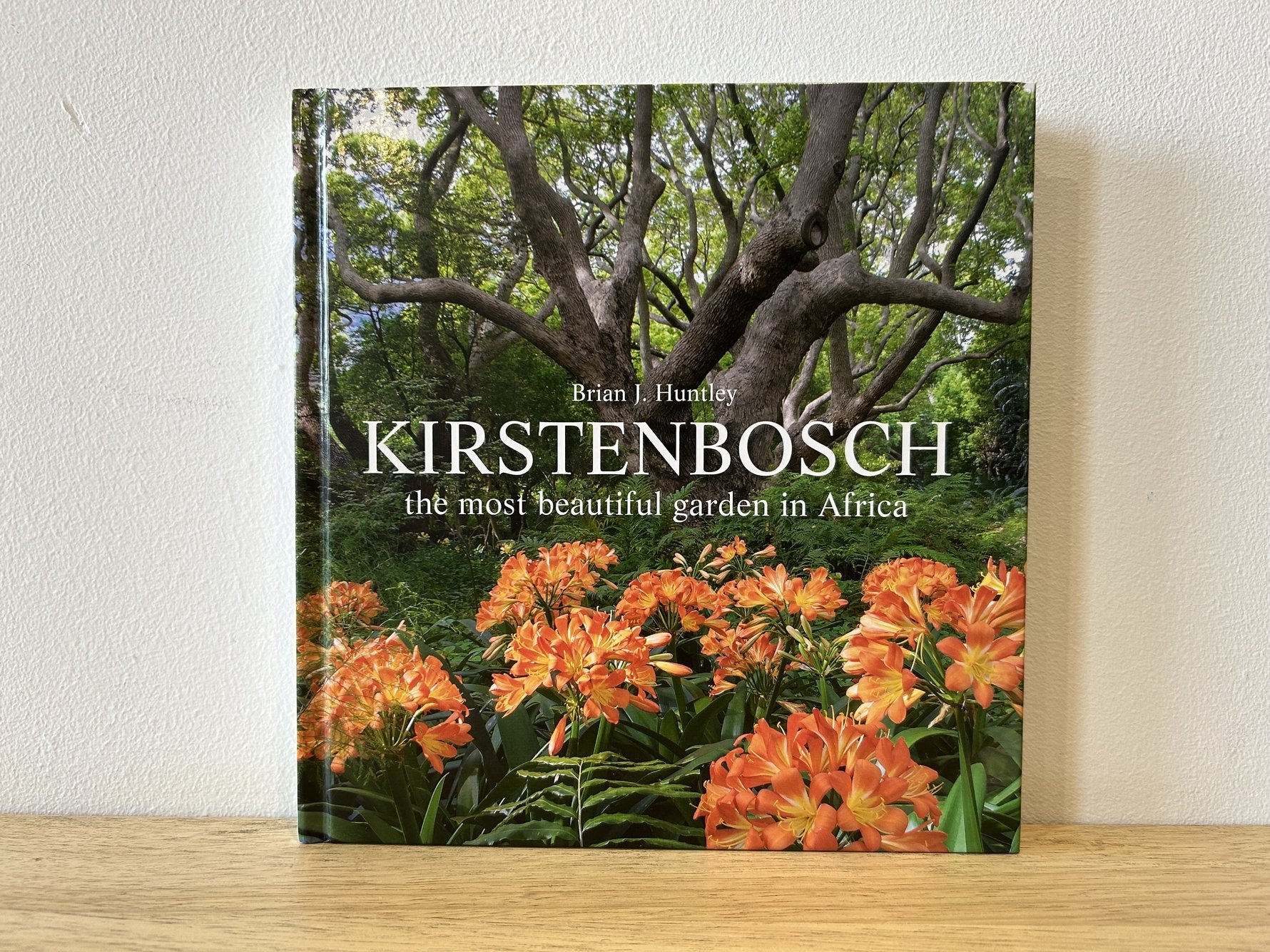
All quotes in this guide are from Brian J. Huntley's book, Kirstenbosch – the most beautiful garden in Africa. Buy a copy here.


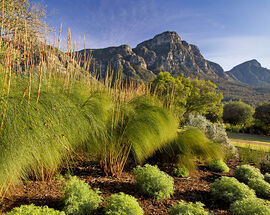
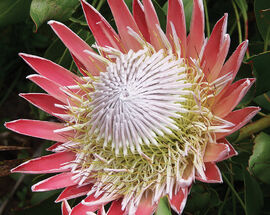
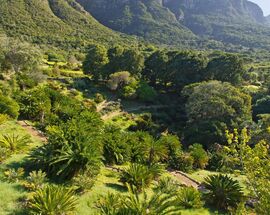


Comments